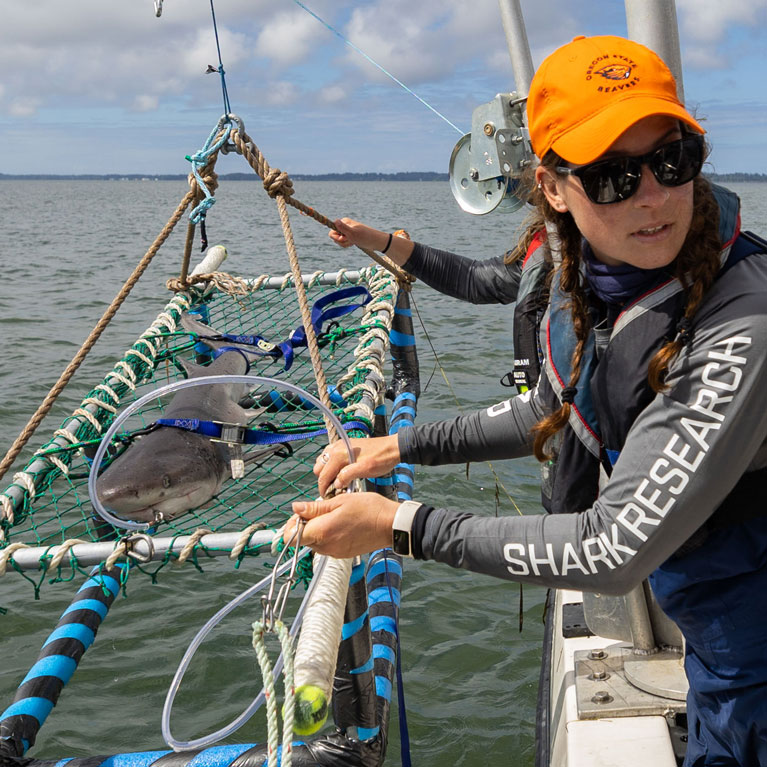Missing the target? Refining spiny dogfish fishery surveys
Populations of the Pacific spiny dogfish are in freefall, but are current surveys assessing the right habitats to make management decisions? Alexandra worries that the absence of movement data from current fisheries surveys means that a part of their story is not being used. In fact, authorities have halted all management action until movement data are provided. Alexandra is tracking the dogfish using acoustic telemetry and will relate how these sharks move in the water to environmental factors before handing the data over to stock assessors and fisheries managers.
Originally from the landlocked city of Cincinnati, Ohio, I was quite young when my interest in the ocean first developed. I credit this fascination to my initial fear of sharks and unfamiliarity with the marine environment, which prompted a decades-long exploration of the sea and its predators. I began by volunteering at the local aquarium and reading every book I could find on sharks and their relatives. After graduating from university with degrees in biology and English, I interned with the Bimini Biological Field Station and through the Oceans Research programme in South Africa, obtaining hands-on...
Assessing the Need for Protection in a Critical Bycatch Species: Pacific Spiny Dogfish
Our objective is to acoustically track Pacific spiny dogfish to determine whether current surveys to assess the population are targeting the right habitats. These data will be directly incorporated in the next stock assessment for the species to convey the degree to which this population is declining, the drivers of this decline and what actions are necessary to reverse these trends.
The Pacific coast stock of Pacific spiny dogfish is thought to be in dramatic decline. However, the survey design used to assess the population is imperfect and needs to be informed by data on dogfish movement patterns. Our results will be used to initiate a new stock assessment that uses movement information to refine estimates of dogfish numbers. This assessment will then determine whether precautionary measures are necessary to prevent further population declines.
The dogfish is a small, common predator in the eastern North Pacific Ocean, where it has been subjected to intense fishing pressure since the 1940s. Today, dogfish overlap substantially with valuable fisheries and are thought to be taken mostly as bycatch. In 2021, an assessment of the dogfish stock along the west coast of the USA suggested that this population had declined dramatically, to the point where management measures may need to be taken to prevent further capture as bycatch. However, the survey data used to inform population estimates for this assessment were imperfect, as the survey didn’t have movement data on dogfish to target its efforts. Consequently, the state and federal management bodies within this region are calling for a new assessment, informed by better movement data, to determine the next step to prevent further dogfish declines.
Importantly, a new assessment will only be initiated if new movement data are available, and in the meantime further management action has been halted. This project is designed to collect the information necessary to initiate and inform a new assessment. It will be part of a larger study on dogfish movements, but focuses specifically on juveniles. Juvenile dogfish represent a large proportion of the animals captured as bycatch in the fisheries. However, they exhibit different movement patterns to adults. In addition, electronic tags, which are being used to study the movement patterns of adults, are too large to affix to the juveniles. We have therefore dedicated a special effort to acoustically tagging and tracking this understudied age class. These data will then be integrated with those from adults as part of the larger project to inform the next assessment of this entire population.
- To collect acoustic movement data on juvenile dogfish.
- To characterise horizontal and vertical movements of juvenile dogfish based on tagging data and model their relationships to environmental factors.
- To share this information with stock assessors, fishing communities and the managers who will make and enforce decisions about the next steps in dogfish conservation.


